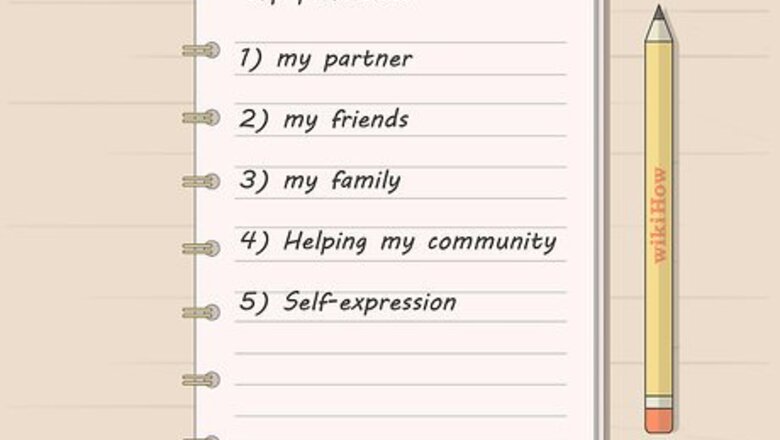
views
Learning about Yourself
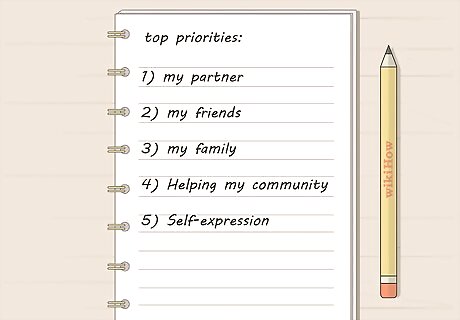
Rank your top 5-10 priorities so you know what’s important to you. Make a list of the things you most value in life, such as your family. Then, choose 5-10 items on your list that are most valuable to you. Rank them in order of importance, with 1 being your top priority. This helps you understand what’s truly important to you. For instance, your list might include 1) Your partner, 2) Your friends, 3) Your family, 4) Helping your community, 5) Self-expression.
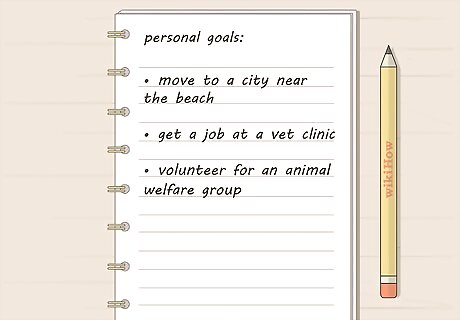
Make a list of your personal goals to find what you want in life. Imagine your ideal life and what you would be doing. Then, write down what goals you’d need to accomplish to get your dream life. Rank these goals in order of importance so you know what you want to achieve in life. For instance, let’s say you dream of living by the beach and helping animals. You might set goals to move to a city near the beach, get a job at a vet clinic, and volunteer for an animal welfare group.
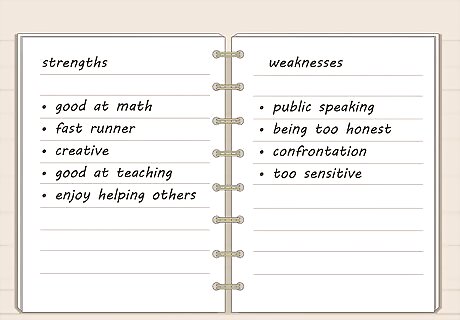
Identify your strengths and weaknesses. Knowing your strengths and weaknesses helps you understand yourself so you can live your best life. Discover your strengths by assessing your knowledge, skills, and traits. Additionally, think of 3-5 times when you felt most successful in life. Then, make a list of areas where you want to improve to find your weaknesses. For example, you might write down that you’re good at math, are a fast runner, and are creative. As another example, you may decide that a time you felt most successful was when you helped your friend with their homework. This might help you realize that you’re good at teaching and enjoy helping others. When it comes to weaknesses, focus on what you can improve. For instance, you might struggle with public speaking, which could be a weakness for you.

Take online psychometric tests to learn more about your personality. Do an online search for personality tests that can help you learn more about your personal traits, your learning style, and your strengths. Do several different tests to help you learn more about yourself. Keep a copy of your results so you can review them when you’re reflecting on yourself. For example, you might take an online test to find your Myers-Briggs Type Indicator, which helps you understand your personality. You might also take quizzes to evaluate your verbal and numerical reasoning skills.

Write about your feelings and experiences in a journal. Journaling helps you better understand your thoughts and emotions. Set a goal to write in your journal every day, even if you just write a little. Discuss what’s happening in your life and how you feel. Then, review what you’ve written to help you self-reflect. To get the most out of your journaling habit, set a time to revisit your old entries. For instance, you might reread the prior month’s entries on the first weekend of the month. Do your best to write every day. It’s okay if you only have time to write a quick list or jot down incomplete sentences.Variation: Go for a walk or jog to clear your mind and think. Moving your body may help you gain clarity about what’s going on in your life.
Building Emotional Awareness

Allow yourself to feel your emotions so they pass. Part of self awareness is being able to understand your emotions. Acknowledge how you’re feeling and give yourself permission to experience the emotion. This allows your feelings to pass. Fighting or suppressing your emotions can make them boil over and makes it take longer for you to work through them. Be honest about how you feel and give yourself time to deal with it. For example, you might feel sad after getting passed over for a promotion. Don’t try to fight the feeling! Tell yourself, “I’m sad right now because I thought I was going to get the job. It’s okay to feel this way.”

Incorporate stress relievers into your routine to prevent burn out. Stress is a normal part of life, but it can be harmful in large doses. When you’re under a lot of stress, you might not be able to deal with your emotions. To help you manage your stress, identify stress relievers that work for you. Then, incorporate them in your daily routine. For instance, you might call a friend after a stressful day at work, color in an adult coloring book to decompress, or take a warm bath to release the tension in your body. Try out different stress relievers to see what works for you. Options include things like going for a walk, journaling, sipping on hot tea, playing with your pet, reading, or engaging in a hobby.

Determine what triggers you emotionally to understand yourself. Think about the times you’ve gotten really upset in the past. Then, identify what was happening in that moment. This is an emotional trigger that you have. Knowing your triggers helps you better manage your emotional reactions to them. For example, let’s say you blew up at your friend for yelling at a dog. You might realize that seeing people be mean to animals is an emotional trigger for you. In the future, you might take a deep breath and count to 10 before you address your concerns about how animals are being treated.

Use mindfulness to stay focused on the present moment. Mindfulness helps you stay grounded in the present so you aren’t worrying about the past or future. To be more mindful, engage your 5 senses of sight, sound, smell, touch, and taste. Here are some ways to do this: Sight: Describe what you see around you or focus on a specific color. Sound: Notice the sounds you hear in your environment or turn on some music. Smell: Pick out the smells around you or sniff an essential oil. Touch: Feel the texture of an item or rub your hand on your skin. Taste: Stick your tongue out to taste the air or chew a piece of gum.
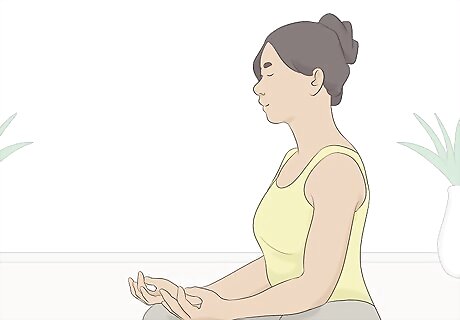
Meditate for at least 10 minutes a day for a clear mind. Daily meditation helps you calm your mind so you can think better. Additionally, it helps you stay relaxed so you’re better able to control your emotions. For a simple meditation, sit in a comfortable position and close your eyes. Then, focus on your breath. If your mind wanders, bring it back to your breath. Look for guided meditations online or use a free app, such as Headspace, Calm, or Insight Timer.
Getting Feedback from Others

Ask people whose opinions you value to give you feedback. Identify people in your life who you think will give you an honest, constructive evaluation of yourself. Then, ask them to tell you how they perceive you, what they think your strengths are, and how you can improve. Collect their feedback and review it to better understand yourself. For instance, you might send 5 of your closest friends and family members an email asking them for their opinion about you. You might ask the following questions: 1) What 10 words would you use to describe me? 2) What are my top 5 strengths? 3) What are 3 ways that I could improve myself?

Pay attention to how others react to you. Watch other people’s body language when they’re around you. Notice if they appear comfortable and approach you with ease or if they keep their distance or close themself off. Look for trends in how people act around you to get an idea about how you’re perceived. A person has open body language when they face you, keep their arms open or at their sides, and don’t cross their legs when sitting. They have closed body language when they turn away from your, fold their arms across their body, or cross their legs while sitting. Keep in mind that how people act around you is partially based on their personality and what's comfortable for them. Don’t assume that someone who is folding their arms in front of their body is offended by you. They might just be a nervous person.
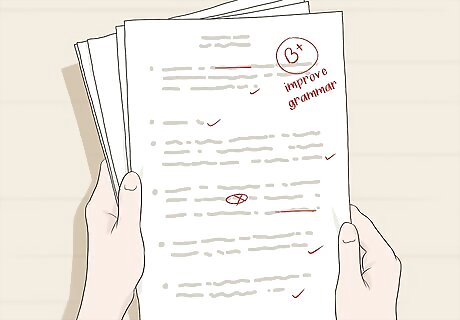
Review the feedback you get at work or school. You probably receive regular feedback about your job performance or academic progress. Read the critiques or job reviews that you receive. Additionally, talk to your supervisor or instructor to ask questions or learn more about your progress. Then, implement the feedback to improve your performance. For example, read over your performance review at work. Similarly, review your grades and written comments on school assignments. If your workplace or class doesn’t have built-in reviews, ask your supervisor or instructor to give you regular feedback. For instance, they might review your performance monthly or quarterly.

Get a friend to film you so you can watch yourself. Watching yourself on video allows you to view how others see your facial expressions and mannerisms. Ask your friend to make a video of you while you're having a conversation or giving a presentation. Then, watch the video to see what you can learn about yourself. Ask your friend to film you during different activities. For instance, they might film you talking with a friend, interacting with an authority figure, and giving a presentation. This allows you to evaluate yourself in different scenarios. It’s best to make several different videos at different times so you can watch yourself on different days.




















Comments
0 comment